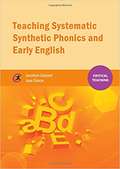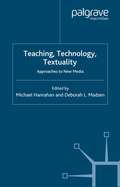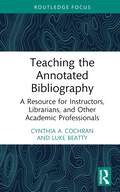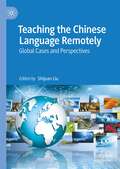- Table View
- List View
Teaching Systematic Synthetic Phonics and Early English (PDF)
by Jonathan Glazzard Jane StokoeAn essential guide for all primary trainees and teachers. The text addresses the specifics of teaching English in the early years and importantly places systematic synthetic phonics within the context of early English as a whole. It starts by examining the fundamental role of communication and language in laying the foundations for literacy development. It explores the importance of early sound discrimination, rhyme, alliteration, oral blending and oral segmentation, as well as the importance of developing children s visual discrimination skills. The text critically examines the role of systematic synthetic phonics as an approach for teaching children to read, and its application in both reading and writing is fully covered. Other key chapters include literacy through the wider learning environment, supporting children with literacy difficulties and assessing English in the early years.
Teaching Systematic Synthetic Phonics in Primary Schools
by Angela Carss David Waugh Wendy JolliffeSystematic synthetic phonics is a key strategy in the teaching of reading. This text supports trainee teachers working towards primary QTS in how to use phonics effectively. It explores what works in phonics teaching, and why. It begins with the subject knowledge that underpins effective teaching and goes on to explore pedagogy from the early years to Key Stage 2. The book includes a review of different popular phonics programmes, set against the DfE (2011) criteria for high-quality phonics teaching. This second edition has been updated in line with the new National Curriculum, includes new guidance on the Year 1 phonics screening check and new lessons ideas and practical guidance for teaching phonics.
Teaching Systematic Synthetic Phonics in Primary Schools
by Angela Carss David Waugh Wendy JolliffeSystematic synthetic phonics is a key strategy in the teaching of reading. This text supports trainee teachers working towards primary QTS in how to use phonics effectively. It explores what works in phonics teaching, and why. It begins with the subject knowledge that underpins effective teaching and goes on to explore pedagogy from the early years to Key Stage 2. The book includes a review of different popular phonics programmes, set against the DfE (2011) criteria for high-quality phonics teaching. This second edition has been updated in line with the new National Curriculum, includes new guidance on the Year 1 phonics screening check and new lessons ideas and practical guidance for teaching phonics.
Teaching Systematic Synthetic Phonics in Primary Schools (Transforming Primary QTS Series)
by Angela Gill David Waugh Wendy JolliffeThe government prioritizes systematic synthetic phonics as a key strategy in the teaching of reading and this is your guide to teaching systematic synthetic phonics in primary schools. This text supports trainee teachers working towards primary QTS through the exploration of a range of aspects of phonics teaching. It gives a balance of research and practice and allows trainees to develop and in-depth understanding of what works in phonics teaching, and why. It begins with the subject knowledge that underpins effective teaching - key aspects of the alphabetic code from discriminating sounds and phonemes to teaching long vowel phonemes and their different spellings and pronunciations. It goes on to explore pedagogy from the early years to Key Stage 2 giving guidance on, among others, systematic progression, intervention and multi-sensory and interactive methods. The title includes a review of different popular phonics programmes, set against the DfE (2011) criteria for high-quality phonics teaching. This third edition has been updated in line with changes in primary education. A new section includes classroom case studies and lesson ideas for teachers to learn about best practice from other teachers.
Teaching Systematic Synthetic Phonics in Primary Schools (Transforming Primary QTS Series)
by Wendy Jolliffe David Waugh Angela GillThe government prioritizes systematic synthetic phonics as a key strategy in the teaching of reading and this is your guide to teaching systematic synthetic phonics in primary schools. This text supports trainee teachers working towards primary QTS through the exploration of a range of aspects of phonics teaching. It gives a balance of research and practice and allows trainees to develop and in-depth understanding of what works in phonics teaching, and why. It begins with the subject knowledge that underpins effective teaching - key aspects of the alphabetic code from discriminating sounds and phonemes to teaching long vowel phonemes and their different spellings and pronunciations. It goes on to explore pedagogy from the early years to Key Stage 2 giving guidance on, among others, systematic progression, intervention and multi-sensory and interactive methods. The title includes a review of different popular phonics programmes, set against the DfE (2011) criteria for high-quality phonics teaching. This third edition has been updated in line with changes in primary education. A new section includes classroom case studies and lesson ideas for teachers to learn about best practice from other teachers.
Teaching Systematic Synthetic Phonics in Primary Schools (Transforming Primary QTS Series)
by David Waugh Wendy Jolliffe Angela GillThe government prioritizes systematic synthetic phonics as a key strategy in the teaching of reading. This core text is your guide to teaching systematic synthetic phonics in primary schools. The book′s balance of research and practice and its focused approach enables you to develop an in-depth understanding of what works in phonics teaching, and why. It begins with the subject knowledge that underpins effective teaching and goes on to explore pedagogy from the early years to Key Stage 2. It includes guidance on systematic progression, intervention and multi-sensory and interactive methods. This 4th edition includes a new section ′Challenges in learning and teaching phonics′ supporting you to meet the individual needs of children.
Teaching Systematic Synthetic Phonics in Primary Schools (Transforming Primary QTS Series)
by David Waugh Wendy Jolliffe Angela GillThe government prioritizes systematic synthetic phonics as a key strategy in the teaching of reading. This core text is your guide to teaching systematic synthetic phonics in primary schools. The book′s balance of research and practice and its focused approach enables you to develop an in-depth understanding of what works in phonics teaching, and why. It begins with the subject knowledge that underpins effective teaching and goes on to explore pedagogy from the early years to Key Stage 2. It includes guidance on systematic progression, intervention and multi-sensory and interactive methods. This 4th edition includes a new section ′Challenges in learning and teaching phonics′ supporting you to meet the individual needs of children.
Teaching Systematic Synthetic Phonics in Primary Schools (Transforming Primary QTS Series)
by David Waugh Wendy Jolliffe Angela GillThe government prioritizes systematic synthetic phonics as a key strategy in the teaching of reading. This core text is your guide to teaching systematic synthetic phonics in primary schools. The book′s balance of research and practice and its focused approach enables you to develop an in-depth understanding of what works in phonics teaching, and why. It begins with the subject knowledge that underpins effective teaching and goes on to explore pedagogy from the early years to Key Stage 2. It includes guidance on systematic progression, intervention and multi-sensory and interactive methods. This 4th edition includes a new section ′Challenges in learning and teaching phonics′ supporting you to meet the individual needs of children.
Teaching, Technology, Textuality: Approaches to New Media (Teaching the New English)
by Michael Hanrahan Deborah L. MadsenThis collection of original essays discusses the implications of the new media for the creation, delivery and assessment of English studies. Strategies by which digital technologies can serve professional, scholarly and pedagogical needs in a completely new way are explored in the context of the role and mission of humanities in the electronic age.
Teaching the Annotated Bibliography: A Resource for Instructors, Librarians, and Other Academic Professionals
by Cynthia A. Cochran Luke BeattyThis book informs instructors and librarians about the history, aims, and pedagogical uses of the annotated bibliography. A companion to the authors' Writing the Annotated Bibliography, this text enables instructors to better understand the annotated bibliography not only as a tool for research and composition but also as a valuable pedagogical tool. It provides practical guidance along with assignments, lesson plans, assessment rubrics, and other tools for using annotated bibliographies in effective and nuanced ways. It also contains annotated bibliography samples in APA, MLA, and Chicago styles. This practical book is of great use to instructors of composition and research skills, librarians, curriculum designers, writing center directors, and education professionals.
Teaching the Annotated Bibliography: A Resource for Instructors, Librarians, and Other Academic Professionals
by Cynthia A. Cochran Luke BeattyThis book informs instructors and librarians about the history, aims, and pedagogical uses of the annotated bibliography. A companion to the authors' Writing the Annotated Bibliography, this text enables instructors to better understand the annotated bibliography not only as a tool for research and composition but also as a valuable pedagogical tool. It provides practical guidance along with assignments, lesson plans, assessment rubrics, and other tools for using annotated bibliographies in effective and nuanced ways. It also contains annotated bibliography samples in APA, MLA, and Chicago styles. This practical book is of great use to instructors of composition and research skills, librarians, curriculum designers, writing center directors, and education professionals.
Teaching the Art of Poetry: The Moves
by Baron Wormser A. David CappellaConcise and accessible, this guide to teaching the art of poetry from Shakespeare to contemporary poets enables anyone to learn about how poets approach their art. Teachers can use this book to explore any facet or era of poetry. Any reader can use it as an entryway into the art of poetry. Teaching the Art of Poetry shows poetry as a multi-faceted artistic process rather than a mystery on a pedestal. It demystifies the art of poetry by providing specific historical, social, and aesthetic contexts for each element of the art. It is a nuts-and-bolts approach that encourages teachers and students to work with poetry as a studio art--something to be explored, challenged, assembled and reassembled, imagined, and studied--all the things that an artist does to present poetry as a search for meaning. This book advocates poetry as an essential tool for aesthetic, cultural, and linguistic literacy. It portrays poetry as an art rather than a knowledge base, and methods for integrating the art of poetry into the school curriculum. The authors' intention is not to fill gaps; it is to change how poetry is presented in the classroom, to change how it is taught and how students think about it. Teaching the Art of Poetry: * Emphasizes hands-on experiences. Over 160 exercises focus attention on the dynamics of the art of poetry. Activities include group work, peer editing, critical thinking skills, revising drafts, focused reading, oral communication, listening skills, and vocabulary, as well as mechanics and usage. * Features a week-long lesson plan in each chapter to aid the teacher. These relate the main aspects of each chapter to classroom activities and, in addition, include a "Beyond the Week" section to promote further investigation of the topic. * Promotes an integrated approach to poetry. The examples used in each chapter show poetry as a living tradition. * Makes extensive use of complete poems along with extracts from many others. * Does not talk down to teachers--is teacher oriented and jargon free.
Teaching the Art of Poetry: The Moves
by Baron Wormser A. David CappellaConcise and accessible, this guide to teaching the art of poetry from Shakespeare to contemporary poets enables anyone to learn about how poets approach their art. Teachers can use this book to explore any facet or era of poetry. Any reader can use it as an entryway into the art of poetry. Teaching the Art of Poetry shows poetry as a multi-faceted artistic process rather than a mystery on a pedestal. It demystifies the art of poetry by providing specific historical, social, and aesthetic contexts for each element of the art. It is a nuts-and-bolts approach that encourages teachers and students to work with poetry as a studio art--something to be explored, challenged, assembled and reassembled, imagined, and studied--all the things that an artist does to present poetry as a search for meaning. This book advocates poetry as an essential tool for aesthetic, cultural, and linguistic literacy. It portrays poetry as an art rather than a knowledge base, and methods for integrating the art of poetry into the school curriculum. The authors' intention is not to fill gaps; it is to change how poetry is presented in the classroom, to change how it is taught and how students think about it. Teaching the Art of Poetry: * Emphasizes hands-on experiences. Over 160 exercises focus attention on the dynamics of the art of poetry. Activities include group work, peer editing, critical thinking skills, revising drafts, focused reading, oral communication, listening skills, and vocabulary, as well as mechanics and usage. * Features a week-long lesson plan in each chapter to aid the teacher. These relate the main aspects of each chapter to classroom activities and, in addition, include a "Beyond the Week" section to promote further investigation of the topic. * Promotes an integrated approach to poetry. The examples used in each chapter show poetry as a living tradition. * Makes extensive use of complete poems along with extracts from many others. * Does not talk down to teachers--is teacher oriented and jargon free.
Teaching the Chinese Language Remotely: Global Cases and Perspectives
by Shijuan LiuThis edited book brings together global perspectives and case studies from five continents to provide an international picture of teaching Chinese remotely. It consists of 15 original chapters by 21 authors from 10 countries. Addressing both practice and research, these chapters collectively offer a comprehensive view of how Chinese language courses worldwide were urgently moved to fully online during the early stages of the Covid-19 pandemic.This edited volume reports fresh and first-hand experiences of Chinese language instructors and students in different countries as well as their perceptions of issues regarding remote teaching and learning in an emergency situation.The book will be of interest to Chinese language teachers and students, as well as scholars with a focus on language education and online teaching and learning more broadly.
Teaching the Common Core Literature Standards in Grades 2-5: Strategies, Mentor Texts, and Units of Study
by Lisa MorrisShifting your literature instruction to meet the Common Core can be tricky. The standards are specific about how students should analyze characters, themes, point of view, and more. In this new book, Lisa Morris makes it easy by taking you through the standards and offering tons of practical strategies, tools, and mentor texts for grades 2-5. She shows you how to combine the standards into effective units of study so that you can teach with depth rather than worry about coverage. Topics covered include: Teaching questioning, inferring, and author’s purpose; Guiding readers to look at themes and write summaries; Showing students how to recognize structural elements of literature; Teaching the craft of writing and vocabulary development; and Helping students analyse characters and character development. Throughout this highly practical book, you’ll find a variety of charts and other graphic organizers that can be easily adapted for classroom use. A list of suggested mentor texts is also available as a free eResource from our website, www.routledge.com/books/details/9781138856172.
Teaching the Common Core Literature Standards in Grades 2-5: Strategies, Mentor Texts, and Units of Study
by Lisa MorrisShifting your literature instruction to meet the Common Core can be tricky. The standards are specific about how students should analyze characters, themes, point of view, and more. In this new book, Lisa Morris makes it easy by taking you through the standards and offering tons of practical strategies, tools, and mentor texts for grades 2-5. She shows you how to combine the standards into effective units of study so that you can teach with depth rather than worry about coverage. Topics covered include: Teaching questioning, inferring, and author’s purpose; Guiding readers to look at themes and write summaries; Showing students how to recognize structural elements of literature; Teaching the craft of writing and vocabulary development; and Helping students analyse characters and character development. Throughout this highly practical book, you’ll find a variety of charts and other graphic organizers that can be easily adapted for classroom use. A list of suggested mentor texts is also available as a free eResource from our website, www.routledge.com/books/details/9781138856172.
Teaching the Content Areas to English Language Learners in Secondary Schools: English Language Arts, Mathematics, Science, and Social Studies (English Language Education #17)
by Alandeom W. Oliveira Luciana C. de Oliveira Kathryn M. Obenchain Rachael H. KenneyThis practitioner-based book provides different approaches for reaching an increasing population in today’s schools - English language learners (ELLs). The recent development and adoption of the Common Core State Standards for English Language Arts and Literacy in History/Social Studies, Science, and Technical Subjects (CCSS-ELA/Literacy), the Common Core State Standards for Mathematics, the C3 Framework, and the Next Generation Science Standards (NGSS) highlight the role that teachers have in developing discipline-specific competencies. This requires new and innovative approaches for teaching the content areas to all students.The book begins with an introduction that contextualizes the chapters in which the editors highlight transdisciplinary theories and approaches that cut across content areas. In addition, the editors include a table that provides a matrix of how strategies and theories map across the chapters. The four sections of the book represent the following content areas: English language arts, mathematics, science, and social studies. This book offers practical guidance that is grounded in relevant theory and research and offers teachers suggestions on how to use the approaches described.
Teaching the Cult of Literature in the French Third Republic
by M. GuineyThis book explores literature in its role as a sacred text within the confines of 19th-century French primary and secondary education, helping the school to take over the role of spiritual authority from the Catholic Church.
Teaching the Dimensions of Literacy: A Conceptual Base For The Teaching Of Reading And Writing In School Settings
by Stephen Kucer Cecilia SilvaTeaching the Dimensions of Literacy provides both the conceptual knowledge to support teachers' instructional decisions in the reading/literacy classroom and a multitude of instructional strategy lessons for classroom use with both monolingual and bilingual students. It proposes that teachers need to help children become code breakers (the linguistic dimension), meaning makers (the cognitive dimension), text users and critics (the sociocultural dimension), and scientists (the developmental dimension). Acknowledging and addressing all four dimensions, this text links literacy theory, literacy research, and literacy practice in a useable way. Covering both reading and writing, it features clear, concise, and useable reading and writing strategy lessons and ways to modify them for different types of students. Changes in the Second Edition: Entirely reorganized, the text is more user friendly, builds a stronger link between theory and practice, and makes it is easier for teachers to locate appropriate strategy lessons to use with their students. Academic literacy is addressed more fully.
Teaching the Dimensions of Literacy
by Stephen Kucer Cecilia SilvaTeaching the Dimensions of Literacy provides both the conceptual knowledge to support teachers' instructional decisions in the reading/literacy classroom and a multitude of instructional strategy lessons for classroom use with both monolingual and bilingual students. It proposes that teachers need to help children become code breakers (the linguistic dimension), meaning makers (the cognitive dimension), text users and critics (the sociocultural dimension), and scientists (the developmental dimension). Acknowledging and addressing all four dimensions, this text links literacy theory, literacy research, and literacy practice in a useable way. Covering both reading and writing, it features clear, concise, and useable reading and writing strategy lessons and ways to modify them for different types of students. Changes in the Second Edition: Entirely reorganized, the text is more user friendly, builds a stronger link between theory and practice, and makes it is easier for teachers to locate appropriate strategy lessons to use with their students. Academic literacy is addressed more fully.
Teaching the Early Modern Period
by Derval Conroy and Danielle ClarkeThis innovative project unites leading scholars of English, History and French to examine the challenges of teaching early modern literature, history and culture within higher education. The volume sets out a variety of approaches to teaching the period and aims to revitalize the connection between teaching and research.
Teaching the Gothic (Teaching the New English)
by A. Powell A. SmithTeaching the Gothic provides a clear and accessible account of how scholarship on the Gothic has influenced the way in which the Gothic is taught. The book examines a range of topics including Gothic criticism, Theory, Romantic Gothic, Victorian Gothic, Female Gothic, Gothic Sexualities, Gothic Film and Postgraduate developments.
Teaching the Language Arts: Forward Thinking in Today's Classrooms
by Elizabeth Dobler Denise Johnson Thomas DeVere WolseyTeaching the Language Arts helps readers envision their future classrooms, including the role technology will play, as they prepare to be effective teachers. The book’s multimedia digital format represents a distinctive way to learn about teaching—combining traditional and electronic content, resources, and pedagogy to create a powerful, interactive experience that encourages active learning. Readers can explore a rich array of teaching tools and experiences, including an effective blend of classroom photographs (taken by the authors during school visits), student samples, podcast interviews with teachers and students, classroom videos, and online resources—all of which allow readers to learn from real-world classrooms. This book’s unique and engaging voice, supported by its multimedia approach, will help future and in-service teachers bring the language arts to life in their own classrooms. Visit the Companion Website at www.routledge.com/cw/dobler for information on accessing the interactive e-book and additional ideas and resources to help you and your students use it to its full potential.
Teaching the Language Arts: Forward Thinking in Today's Classrooms
by Elizabeth Dobler Denise Johnson Thomas DeVere WolseyTeaching the Language Arts helps readers envision their future classrooms, including the role technology will play, as they prepare to be effective teachers. The book’s multimedia digital format represents a distinctive way to learn about teaching—combining traditional and electronic content, resources, and pedagogy to create a powerful, interactive experience that encourages active learning. Readers can explore a rich array of teaching tools and experiences, including an effective blend of classroom photographs (taken by the authors during school visits), student samples, podcast interviews with teachers and students, classroom videos, and online resources—all of which allow readers to learn from real-world classrooms. This book’s unique and engaging voice, supported by its multimedia approach, will help future and in-service teachers bring the language arts to life in their own classrooms. Visit the Companion Website at www.routledge.com/cw/dobler for information on accessing the interactive e-book and additional ideas and resources to help you and your students use it to its full potential.
Teaching the Language Arts: Forward Thinking in Today's Classrooms
by Denise Johnson Elizabeth Dobler Thomas DeVere WolseyThis book helps readers envision their future classrooms, including the role technology will play, as they prepare to be successful teachers. Comprehensively updated, the second edition addresses new demands on teaching in traditional and virtual ELA classrooms, and the new ways technology facilitates effective instructional practices. Organized around the receptive language arts—the way learners receive information—and the expressive language arts—the way leaners express ideas—chapters cover all aspects of language arts instruction, including new information on planning and assessment; teaching reading and writing fundamentals; supporting ELLs, dyslexic, and dysgraphic learners; using digital tools; and more. In every chapter, readers can explore a rich array of teaching tools and experiences, which allow readers to learn from real-world classrooms. The eBook+ version includes interactive features and links to the up-to-date Companion Website, with more strategies, and examples of practice and student work. This book’s unique and engaging voice, supported by its many resources, will help future and in-service teachers bring the language arts to life in their own classrooms.















